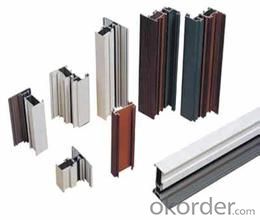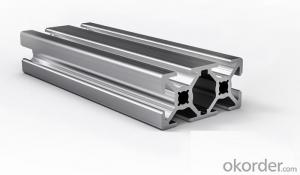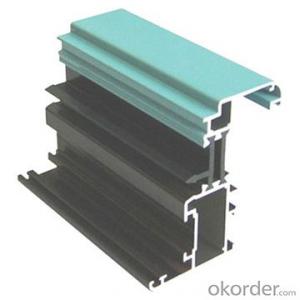Extruded Aluminum Trim Profiles for Doors and Windows
- Loading Port:
- Shanghai
- Payment Terms:
- TT OR LC
- Min Order Qty:
- 5 m.t.
- Supply Capability:
- 1000 m.t./month
OKorder Service Pledge
OKorder Financial Service
You Might Also Like
Specification
1. Structure of Aluminium section profiles for doors and windows Description
Aluminium section profiles for doors and windows is one semi-finished aluminium material. The alloy AA1050 is widly used in building, industry ect. Its weight is much lower than steel. So many customers choosed aluminium material instead of steel.
2. Specification of Aluminium section profiles for doors and windows
Aluminum Profiles | |
Main Specification | |
Alloy | AA1xxx (AA1050, AA1060, AA1070, AA1100 etc.) |
AA3xxx (AA3003, AA3004, AA3005, AA3105 etc.) | |
AA5xxx, AA6XXX (AA5052,AA5083, AA5754, AA6061, AA6062 etc.) | |
AA8xxx(AA8011, AA8006 etc.) | |
Temper | H14,H16, H18, H22, H24, H26, H32,O/F, T4, T6, T651 |
Thickmess | 0.01mm-100mm |
Width | 30mm-1700mm |
Standard | GB/T 3880-2006/ASTM |
Special specification is available on customer's requirement | |
3. Application of Aluminium section profiles for doors and windows
(1).Interior: wall cladding, ceilings, bathrooms, kitchens and balconies, shutters, doors...
(2).Exterior: wall cladding, facades, roofing, canopies, tunnels,column covers , renovations...
(3).Advertisement: display platforms, signboards, fascia, shop fronts...
4. Feature of Aluminium section profiles for doors and windows
Surfact Quality :
Be free from Oil Stain, Dent, Inclusion, Scratches, Stain, Oxide Dicoloration, Breaks, Corrosion, Roll Marks, Dirt Streaks and other defect which will interfere with use,
Mechenical Property:
Chemical Composite and Mechanical Property
5. Certificate of Aluminium section profiles for doors and windows
SGS and ROHS(if client request, paid by client), MTC(plant provided), Certificate of Origin(FORM A, FORM E, CO), Bureau Veritas and SGS (if client request, paid by client), CIQS certificate
6. Image of Aluminium section profiles for doors and windows



7. Package and shipping of Aluminium section profiles for doors and windows
First, plastic cloth with drying agent inside; Second, Pearl Wool ; Third, wooden cases with dry agent , fumigation wooden pallets, aluminum surface could cover blue PVC film
8. FAQ
1) What is the delivery time?
Depends on actual order, around 20 to 35 days
2) What is the QC system:
We have QC staff of 20 persons and advanced equipment, each production is with MTC traced from Aluminum ingot lot.
3) What market do you mainly sell to?
Australia, America, Asia, Middle East, Western Europe, Africa etc
- Q: Are aluminum profiles suitable for exhibition kiosks?
- Yes, aluminum profiles are suitable for exhibition kiosks. Aluminum is lightweight, durable, and easy to work with, making it an ideal material for constructing kiosks. Additionally, aluminum profiles can be customized and offer a sleek and modern appearance, enhancing the overall aesthetics of the exhibition kiosk.
- Q: Can aluminum profiles be used for greenhouse construction?
- Yes, aluminum profiles can be used for greenhouse construction. Aluminum is a popular choice for greenhouse frames due to its durability, lightweight nature, and resistance to corrosion. It is also easy to work with, allowing for flexibility in design and construction. Aluminum profiles provide a strong and stable structure that can withstand harsh weather conditions and provide long-term support for the greenhouse covering materials. Additionally, aluminum frames require minimal maintenance and have a longer lifespan compared to other materials, making them a cost-effective option for greenhouse construction.
- Q: Is it possible to recycle aluminum profiles and use them again in construction projects?
- <p>Yes, aluminum profiles can be recycled and reused in construction. Aluminum is highly recyclable, and the recycling process requires significantly less energy compared to the production of new aluminum. Recycled aluminum maintains its properties, making it suitable for various construction applications. This practice not only conserves resources but also reduces waste and environmental impact.</p>
- Q: What are the different types of hinges used with aluminum profiles?
- There are several types of hinges that can be used with aluminum profiles. Some common types include: 1. Butt hinges: Butt hinges are the most basic type of hinge used with aluminum profiles. They consist of two plates that are connected by a pin, allowing the door or panel to swing open and closed. 2. Piano hinges: Also known as continuous hinges, piano hinges are long, narrow hinges that run the entire length of the door or panel. They are often used for large or heavy doors because they provide extra support and stability. 3. Concealed hinges: As the name suggests, concealed hinges are not visible when the door or panel is closed. They are typically used for cabinet doors or other applications where a clean, seamless appearance is desired. 4. Pivot hinges: Pivot hinges are designed to allow a door or panel to pivot on a single point. They are often used for doors that need to swing in both directions or for doors that are taller than they are wide. 5. European hinges: European hinges, also known as cup hinges or hidden hinges, are commonly used in cabinet doors. They are adjustable and allow the door to be opened and closed smoothly. 6. Self-closing hinges: Self-closing hinges are equipped with a spring mechanism that automatically closes the door or panel after it has been opened. They are often used in high-traffic areas or where it is important to ensure that doors are properly closed. These are just a few examples of the different types of hinges that can be used with aluminum profiles. The choice of hinge will depend on factors such as the application, size and weight of the door or panel, desired aesthetics, and functionality requirements.
- Q: Can aluminum profiles be used in signage or display applications?
- Signage or display applications can utilize aluminum profiles effectively. These profiles possess versatility and lightness, making them perfect for producing durable and visually pleasing signs and displays. They can be easily cut, shaped, and connected together to form personalized frames, panels, and structures for various signage and display purposes. Moreover, aluminum profiles possess exceptional resistance to corrosion, ensuring that the signs or displays remain intact and attractive even in outdoor or high-moisture environments. Additionally, the option to powder coat or anodize aluminum profiles offers a wide array of color choices, enabling branding or customization. In summary, aluminum profiles offer a dependable and cost-effective solution for signage or display applications, providing both practicality and aesthetics.
- Q: What are the methods to prevent water infiltration in the gaps between aluminum profiles during the installation process?
- <p>To prevent water from getting into gaps between aluminum profiles during installation, use high-quality sealants and gaskets. Ensure proper alignment and fit of the profiles to minimize gaps. Install weep holes to allow water to drain out. Apply a water-resistant membrane or flashing behind the profiles. Regularly inspect and maintain the installation to identify and fix any issues promptly. Proper installation techniques and materials selection are crucial to prevent water infiltration.</p>
- Q: in addition to the groove width is not the same as other well differentiated? Is there any difference in wall thickness?
- There must be a difference. There is a distinction between rice weight and wall thickness. For example, Jing Teng Aluminum CompanyJT-8-5050W meters weight is 3.25KG,,JT-10-5050 meters weight is 2.95KG. Specific parameters, you can go to consult the next business
- Q: This question asks about the various types of aluminum profiles that are utilized in interior design applications.
- <p>Aluminum profiles are widely used in interior design for their strength, durability, and aesthetic appeal. Common types include: 1. Linear Profiles for creating sleek lines in furniture and architectural elements; 2. Structural Profiles for load-bearing structures like beams and columns; 3. Decorative Profiles for ornamental purposes, such as moldings and trims; 4. Frame Profiles for framing pictures, mirrors, and other wall-mounted items; 5. Slatwall Profiles for versatile display systems in retail spaces; 6. Handrail Profiles for stairways and balconies, ensuring safety and style; 7. Window and Door Profiles for modern, lightweight, and energy-efficient applications. Each type is chosen based on the specific design requirements and functional needs of the space.</p>
- Q: This question asks for a method to determine the quantity of aluminum profiles needed for a construction project.
- <p>To calculate the amount of aluminum profiles required for a building project, follow these steps: 1. Determine the project's design and specifications to identify where aluminum profiles are needed. 2. Measure the dimensions of the areas requiring aluminum profiles (length, width, height). 3. Calculate the total linear footage needed by multiplying the dimensions. 4. Consider the profile's cross-sectional area and the project's load-bearing requirements. 5. Account for waste and additional material for joints, connections, and potential errors. 6. Consult with suppliers or use industry-standard formulas to determine the exact quantity of profiles needed. 7. Review and adjust calculations as the project progresses to ensure accuracy.</p>
- Q: Which price is expensive for aluminum profiles 6063-T6 and 6063-T5?
- 2.2, second digits: an alloy that indicates the addition of alloying elements or impurities in the original alloy.0: watch master alloy1: table primary alloy is modified by the first timeThe original alloy of table 2: has been modified second times2.3, third, and four digits:Pure aluminum: represents the original alloyAlloy: the designation of individual alloys"- >: the later Hn or Tn indicates the condition of the work hardening or the symbol of the heat treatment state-Hn: indicating the symbol of temper of non heat treated alloys-Tn: the symbol of temper of heat treated alloysT5It is cooled by a high temperature molding process and then artificially aged. The utility model is suitable for the artificial aging product after being cooled by the high temperature forming process without being cold processed (which can be straightened and straightened without affecting the mechanical performance limit).
Send your message to us
Extruded Aluminum Trim Profiles for Doors and Windows
- Loading Port:
- Shanghai
- Payment Terms:
- TT OR LC
- Min Order Qty:
- 5 m.t.
- Supply Capability:
- 1000 m.t./month
OKorder Service Pledge
OKorder Financial Service
Similar products
Hot products
Hot Searches
Related keywords




























